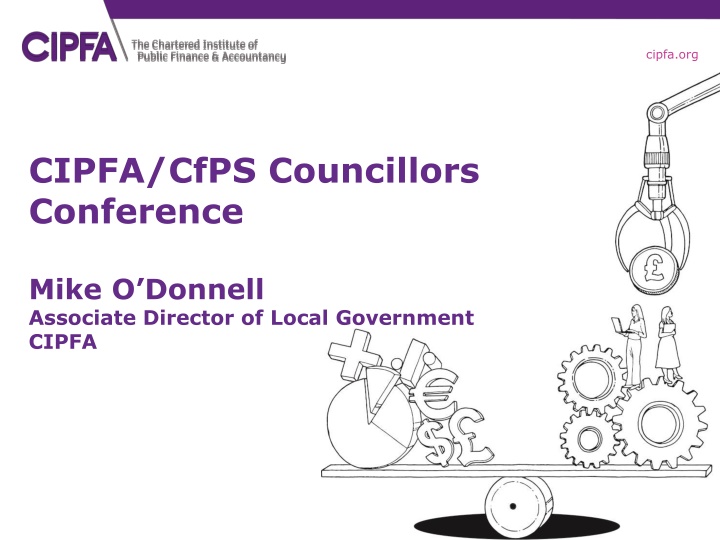
Challenges and Trends in Local Government Financing
Explore the state of public finances in local government, with a focus on spending cuts, efficiency measures, and challenges facing social care services. Discover how funding reductions impact areas such as waste collection, road maintenance, and more. Stay informed about the evolving landscape of local government expenditure and the need for sustainable financial solutions amidst ongoing pressures.
Download Presentation

Please find below an Image/Link to download the presentation.
The content on the website is provided AS IS for your information and personal use only. It may not be sold, licensed, or shared on other websites without obtaining consent from the author. If you encounter any issues during the download, it is possible that the publisher has removed the file from their server.
You are allowed to download the files provided on this website for personal or commercial use, subject to the condition that they are used lawfully. All files are the property of their respective owners.
The content on the website is provided AS IS for your information and personal use only. It may not be sold, licensed, or shared on other websites without obtaining consent from the author.
E N D
Presentation Transcript
cipfa.org CIPFA/CfPS Councillors Conference Mike O Donnell Associate Director of Local Government CIPFA
cipfa.org The state of public finances Spending on public services and benefits payments which make up around 85% of government spending has fallen by about 1% since 2010. Some services more than others which have seen large spending cuts for example prisons down 22% since 2009/10, local government nearly 50%. Meanwhile social care now accounts for 54.4% of local authorities total service spend, up from 45.3% in 2010-11. CIPFA and the Institute for Government s (IFG) Performance Tracker shows public services have become more efficient since the introduction of austerity measures that is, services are managing to deliver services at a lower cost than they did eight years ago. However the Performance Tracker also shows that adult social care cannot continue to operate at their current level of efficiency, and that local authorities risk a serious deterioration of quality.
cipfa.org A longer-term issue: social spending spending vs the rest - 1983-84 to 2018-19 80 70 60 50 40 NHS, Education, welfare 30 All other 20 10 0 Derived from Public Expenditure Statistical Analyses 2015, H M Treasury, Table 4.2 Percentages derived from services expenditure as proportion of all public expenditure
cipfa.org Local government expenditure as % of GDP - 7+ years of reductions as % of GDP Source: OBR
cipfa.org Local government Source: LGA 2017
cipfa.org Local government funding squeeze Sustained real-term falls in government funding 56.3% reduction by 2019/20. Spending on local services - waste collection, road maintenance, food safety, trading standards, libraries has fallen sharply in the last seven years. Squeezed inexorably by growing demands for social care.
cipfa.org Social care Spending has fallen by 5% since 2009. Although day-to-day spending on adult social care fell by nearly 10% in real terms between 2009/10 and 2014/15, levels since then have grown. The recent increase in funding has been supported by the 2015/16 Better Care Fund and the commitment in the 2017 March Budget of an additional 2bn in funding. However, financial pressures persist. The Government has again promised to release a Green Paper that will address (again) social care funding reform.
cipfa.org The common problems for local government to overcome The prospect of austerity in public spending stretching into the middle of the next decade, coupled with economic uncertainty that Brexit brings. Stark contrasts in different councils inherent ability to take advantage of financial sustainability. Geographical and historical determinants dictate likelihood of achieving a sustainable financial position post BRR and Fair funding. Risks associated with regeneration projects and often unfettered commercialism have been growing. Growing service demand. Impact of above varies markedly across the country and across communities.
cipfa.org The future of local government funding Government s Fair Funding Review and Business Rates Retention will they bring about sustainable reform? Northamptonshire County Council crisis has put local government funding pressures under the spotlight.
cipfa.org Tip of iceberg?
cipfa.org The financial stress warning signs learning form CIPFA s resilience reviews Running down reserves increasing rates of decline. Shortening of medium-term financial planning horizons perhaps from three or four years to two or even one. Greater still to be found gaps in saving plans in the early days of austerity, a council might have agreed a four-year financial strategy. Now, authorities have only specified how savings will be achieved for the next financial year. A growing tendency for departments to have unplanned overspends and/or carrying forward undelivered savings into the following year.
cipfa.org Four pillars of resilience 1. Getting routine financial management right ensure basic financial management systems are working effectively. 2. Benchmarking making good use of benchmarking data. 3. Clear plans for delivering savings each authority needs a single, consolidated, living document that tracks its savings plans. 4. Reserves - to manage a clear andtransparent savings programme over the medium term - not to avoid another cut in service level
cipfa.org CIPFA s response to funding crisis A financial resilience index. Professional codification of budget setting and financial management. Funding Advisory Service (FAS). Code of ethics.
cipfa.org Importance of the role of councillors Strength of leadership Oversight and scrutiny Accountability
cipfa.org How CIPFA is supporting councillors CIPFA, in partnership with CfPS, will host further conferences for councillors. CIPFA and CfPS are considering creating a dedicated network for councillors.
cipfa.org THANK YOU Mike O Donnell Associate Director of Local Government
